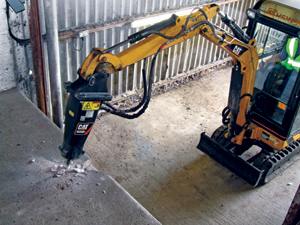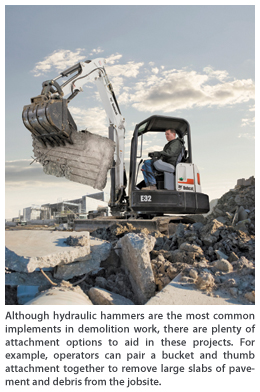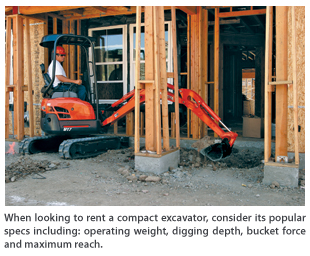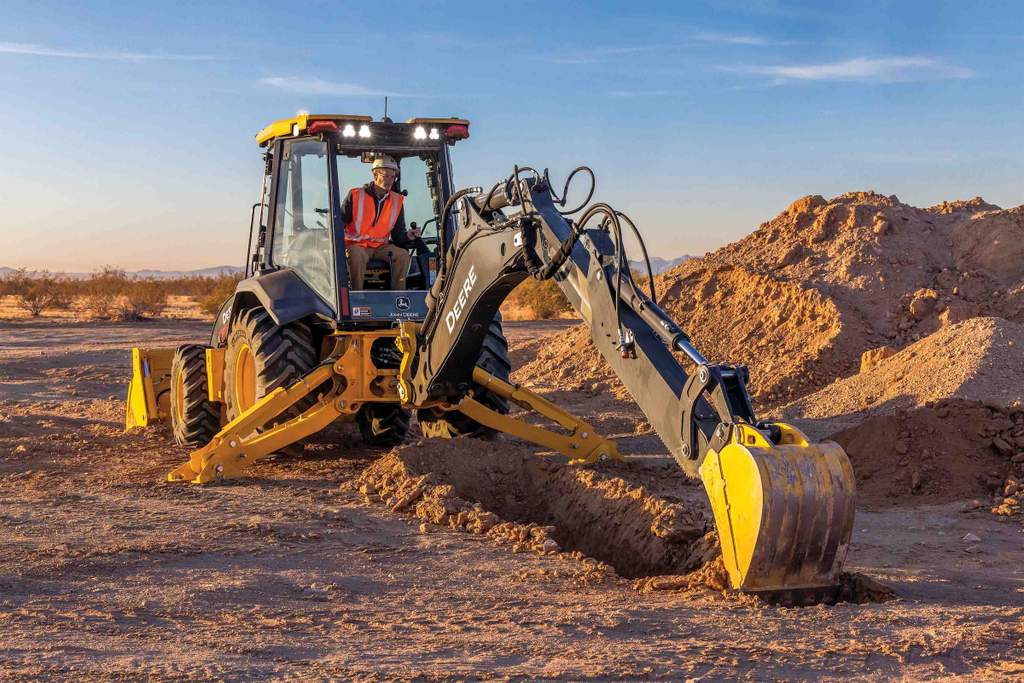The Break Up

 Sometimes the term compact “excavators” is a bit of misnomer. These long-armed tool carriers can do more than just your typical dig operations. Although it’s most commonly known for teaming with a bucket and getting dirty, this versatile piece of equipment is also used in a wide range of applications such as augering, brush mowing, blade work and even demolition. Thanks to its size, strength and ability to use numerous attachments, a compact excavator offers operators a powerful punch in breaking concrete and other materials, particularly when the job moves indoors.
Sometimes the term compact “excavators” is a bit of misnomer. These long-armed tool carriers can do more than just your typical dig operations. Although it’s most commonly known for teaming with a bucket and getting dirty, this versatile piece of equipment is also used in a wide range of applications such as augering, brush mowing, blade work and even demolition. Thanks to its size, strength and ability to use numerous attachments, a compact excavator offers operators a powerful punch in breaking concrete and other materials, particularly when the job moves indoors.
“Despite their smaller size, compact excavators pack enough power to take care of demolition work as efficiently as larger machines and often with more precision,” says Keith Rohrbacker, product manager for Kubota. “Compact excavators are also ideal for demolition jobsites, as they can help operators to see the job through by handling heavy lifting and cleanup of debris.”
With more than a dozen mini ex manufacturers including Bobcat, Caterpillar, Gehl, IHI, JCB, Komatsu, Kubota and Volvo, there are plenty of models to choose from. However, after selecting the right machine for the job, getting it ready for demolition is the next priority. Outfitting a compact excavator for this line of work is not only important to protect the machine, but to ensure safe operation for the crew.
One important adjustment to the machine is adding screens for protection. A guard group, which usually includes front and side screens, should be installed to shield the operator from any dust and debris. An enclosed cab is also a great solution for operators who work in all-day demolition.
“Demolition operations produce a lot dust in the work environment, especially with interior demolition,” says Tom Connor, Bobcat excavator product specialist. “An enclosed cab will help keep the operator comfortable and clean and help reduce noise. With air and heat, an operator can also keep the cab at the temperature best suited to them to keep them working comfortably and productively.”
With dust, debris and machine exhaust, proper ventilation of an indoor jobsite is vital. Since indoor demolition may be in an enclosed area, ventilation techniques should be selected based on the job’s location. On top of keeping a steady stream of clean air, a scrubber/catalytic muffler should be installed on the machine.
Tracks are also something to consider in prepping a compact excavator for this line of work. Since demolition is usually one of the toughest and most demanding applications, Rob Jackson, mini-hydraulic excavator product specialist for Caterpillar, notes that steel tracks are usually preferred for their durability. With sharp pieces of concrete and other materials scattered around, rubber tracks may be easily damaged, causing them to separate or stretch. Ground conditions must always be considered before choosing a particular track. Although steel tracks make for a tougher demolition machine, some indoor jobsites may require minimal damage to flooring — making rubber tracks the best option.
“Most compact excavators in the United States are sold with rubber tracks,” says Jackson. “However, rubber segment tracks, steel tracks and steel tracks with rubber pads are other options that are available. Rubber tracks are the most versatile and will create much less ground disturbance, but steel tracks are much more durable and many times preferred in demolition applications.”

“The individual pads mount directly to the track chain, and the pads are made of a durable rubber composite that provides a much longer track life than rubber,” says David Caldwell, product manager for Komatsu. “Should a road liner pad become damaged, the customer can simply remove four bolts, take off the damaged pad and replace it with a new pad.”
After the machine is prepped for work, combining the excavator with the right attachment is next. In demolition applications, the most common implement is a hydraulic hammer or breaker attachment. To properly pair a compact excavator with this tool, the machine’s hydraulic flow and lifting capacity should be considered. These two factors will help determine what size attachment is needed for the most efficient use.
“Hydraulic requirements of the hammer, both oil flow and pressure must be considered when determining the correct hammer,” explains Thomas Munch, senior project engineer — Global Worktools Services for Caterpillar. “Operating weight of the hydraulic hammer is also a factor — stability of the compact excavator is critical. Too large of a hammer makes for an unstable carrier and too small of a hammer will cause damage to the attachment.”
Noise is also a concern when working indoors. Both Kubota and Caterpillar offer attachments for their excavators that boast quieter operation. Kubota’s Q-Series breakers provide reduced sound levels, by as much as 10 to 12 dBA. Caterpillar’s hammers are designed with a standard silencing feature, which lowers the overall dBA level of the machine and hammer configuration.
Other manufacturers such as Bobcat, Huskie Hammer, Kent and Atlas Copco offer hydraulic hammers and breakers, which range in price from $5,000 to $30,000, depending on the configuration and what size excavator it will be used on. And demolition attachment options don’t end there. Concrete buckets and hydraulic thumbs can be used to remove large slabs of pavement and a variety of debris, says Caldwell. Other popular demolition implements include shears, multi processors, grapples and pulverizers.
After picking out the right attachment, learning how to use it properly is key to a project. With enough machine know-how, operators are able to efficiently maneuver the excavator and its implements for successful indoor demolition.
Getting to Work
Before rolling onto a jobsite, it’s important for an operator to understand his or her surroundings and work environment. Personal protection is also needed. Kendall Aldridge, national sales manager for IHI Compact Excavator Sales, notes that operators should always wear the proper safety gear and refer to OSHA guidelines prior to starting on a project.

“Avoid small irregularities on the surface, which will break easily and cause either idle strokes or an incorrect working angle,” cautions Rohrbacker. “Use the excavator’s boom to press the hammer firmly against the object. Do not pry the hammer with the boom, as this will definitely break the tool.”
If the object moves or its surface breaks during use, the operator should immediately correct the tool’s angle. Constant idle strokes can cause the hammer and side plates to wear out more quickly.
Operators should also not use a hammer in one spot for more than 15 seconds. Working too long in one spot will produce stone dust under the tool and dampen its impact effect, adds Rohrbacker. This can cause the tool to overheat and reduce its overall life. If an object does not break in that time period, stop and change the position of the attachment.
Understanding Upkeep
In demolition and other applications, a solid maintenance plan is needed to keep a good partnership between man and machine. Since demolition can take a tougher toll on an excavator, operators should refer to the machine’s operator’s manual for a detailed maintenance regimen.
“Compact excavator maintenance should be a routine part of any operator’s work schedule in order to avoid excessive downtime and lost productivity from spending valuable time in the shop or having to replace a part,” says Rohrbacker.
Daily maintenance usually requires bucket pin greasing and various checks of hydraulic and engine oils. To make these tasks easier, be sure to have an extra set of filters, oil and other general maintenance items on hand.
“Many manufacturers have moved to 500-hour engine oil change intervals, saving customers time and money,” says Jackson. “Hydraulic oil should be carefully maintained and tested for contamination, but can last several 1,000 hours before changing on some models. As usual, oil and fuel filters will need to be changed as recommended.”
A careful inspection of hydraulic hoses, electrical wires, engine coolant levels and hoses should be done as well. Since demolition often produces a dusty jobsite, operators may need to clean and replace the air filter more frequently.
When preparing for maintenance, don’t forget the attachments. Each implement will require its own upkeep to ensure efficient use. For example, a hydraulic hammer will come with its own manual and detailed maintenance program that should be followed each day. Greasing the breaker should be done regularly. Rohrbacker stresses the importance of keeping the hammer’s hydraulic system clean and offers some basic maintenance tips:
- Do not drop the ends of the hydraulic hoses in the dirt.
- Do not leave the hammer’s in and out ports open onsite for sand and dust to enter.
- Every 10 hours or weekly, the operator should remove the tool’s retaining pin and tool and inspect.
- Every 50 hours or monthly, the operator should check the tool shank and tool bushings for wear.
- Hydraulic hoses should also be checked monthly or every 50 hours.
- Annual service is recommended after 600 operating hours.
By understanding how to properly operate and maintain a compact excavator, crews can use these versatile machines in a variety of applications. With the right equipment and attachments, operators can tackle tough indoor demolition projects safely and efficiently.
Pam Stask is assistant editor of Compact Equipment, based in Peninsula, Ohio.
Picking the Right Rental
Lease the Ideal Compact Excavator for Your Project’s Needs
By Keith Gribbins
When a compact excavator is required for a project, rental is a great option for crews. Before you roll off the rental lot with your supreme machine, you need to do a little homework. First, determine your project parameters before you pick an excavator. Check to see if there are any site constraints such as weight limitations, confined worksite complications or sensitive ground conditions (consider the level of ground pressure required). Weigh those project details with the particular specifications of the compact excavator you’re eyeing. Popular mini ex specs include: operating weight, digging depth, bucket force and maximum reach.
Step onto the house structure of the compact excavator, which contains the operator’s compartment and get a feel for its comfort and utility. Are the controls intuitive? Is there enough space for your operator to be comfortable? Is entry and exit quick and uncomplicated? Work both the boom and backfill blade to determine the smoothness, accuracy and featherability of the joysticks and their control patterns. Ensure that switching from pilot controls to the traditional backhoe configurations (ISO to SAE) is simple. Jump off and kick the rubber on the undercarriage, inspecting the tracks, drive sprockets, rollers and idlers. Consider the option of zero tail swing on the rear, which has become a popular design in the last few years.
Move to the front of the excavator and discover the backfill blade. This mini steel dozer is used for grading, leveling, backfilling and general dozer work. It’s also a stabilizer during digging operators. Inspect for ease of use and durability. Some companies are offering six-way dozer blades for accurate and quick backfilling.
The primary attachments for mini excavators include buckets, thumbs, breakers, augers, compactors, flail mowers and more. Compact excavators have a wide range of buckets (from 8 to 42 in.) that the contractor can use to dig a trench to the exact width, as well as specialty buckets (such as grading buckets, tilt buckets and trencher buckets) for niche applications. Auxiliary hydraulic flow to power attachments on the mini excavator boom typically ranges from 6 to 35 gpm.
New technologies are emerging every year to tweak efficiency and power on small excavators — features like load sensing hydraulics, fuel efficient engines that are quiet and better for the environment, safer operating platforms, extended service intervals and overall ease of maintenance. Quiz your renter about the latest technologies and weigh that market knowledge with the quality of their machine selection, service and pricing.
Keith Gribbins is managing editor of Compact Equipment, based in Peninsula, Ohio.
Safety First
Industry Experts Offer Five Tips for Safe Indoor Demolition
- Read a Good Book: Contractors should follow all safety precautions as outlined in the machine’s operators manual. “Always obey the instructions in the manual provided with the machine,” says Rob Jackson, mini-hydraulic excavator product group for Caterpillar. “This is also usually the place where lift charts are located. When using heavy attachments or lifting heavy objects, always be aware of the lifting capabilities of the machine.”
- Know Your Limits: Make sure to compare the machine’s weight to the floor’s load limit. “Some indoor demolition jobs occur in multi-story buildings or on other types of elevated flooring,” explains Keith Rohrbacker, product manager for Kubota. “Be sure to pay attention to the floor’s weight limitations as compared to the mass of the excavator.”
- Protect Yourself: Since demolition can get messy, screen guards should be installed on the excavator to protect the operator and the machine. “Be sure to install any available screen guards on the front or falling object guards on the top of the machine prior to sending it to a jobsite,” says Jackson. “Hard hats, hearing protection, safety glasses and other personal protective equipment should be worn at all times.”
- Get Acquainted: Before getting to work with the excavator, an operator should make sure he or she understands how to use the machine and check that it’s working properly. “Ensure that every team member or individual that will operate the compact excavator familiarizes themselves with each lever, pedal and joystick, how they operate and where they are found on the machine,” says Rohrbacker. “Double check the equipment for functioning safety features such as lights, horn, fire extinguisher, first aid kit and safety signs.”
- Keep a Close Eye: When working with a compact excavator, an operator needs to be fully aware of his or her surroundings. “Watch for people standing within the machine’s operating radius, as well as for falling debris when working in demolition,” says David Caldwell, product manager for Komatsu. “Always know where utilities are located, both overhead and underground.”





Comments are closed here.